DNA samples of the boy are being taken taken and will be compared with local indigenous Siberian groups to see if he has modern-day day relatives still in the region. The images show scientists as they carefully peel away the cocoon – including birch bark and copper – which led to the mummification of a boy aged six or seven who lived close near to the modern town of Salekhard. The lower part of his face, including his teeth, become suddenly visible for the first time in around eight centuries.
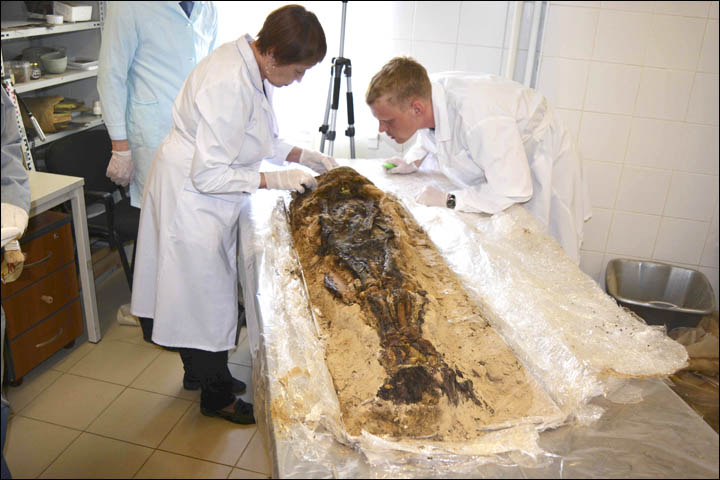
DNA samples of the boy are being taken taken and will be compared with local indigenous Siberian groups to see if he has modern-day day relatives still in the region.
The child’s well preserved remains were found at the Zeleny Yar necropolis, previously seen as belonging to a mystery medieval civilization with links to Persia despite its position on the edge of the Arctic.
Work is also underway to recreate the boy’s face with the help of scientists in South Korea, and a discovery has been made that raw fish was integral to his diet.
Professor Petr Slominsky, head of the Laboratory of Molecular Genetics of Hereditary Diseases at the Institute of Molecular Genetics, Moscow, told The Siberian Times: ‘In June we will travel to places close to Zeleny Yar to gather DNA samples from the local indigenous population, and try to find the genetic connections between them and the people who lived in here in the Middle Ages.
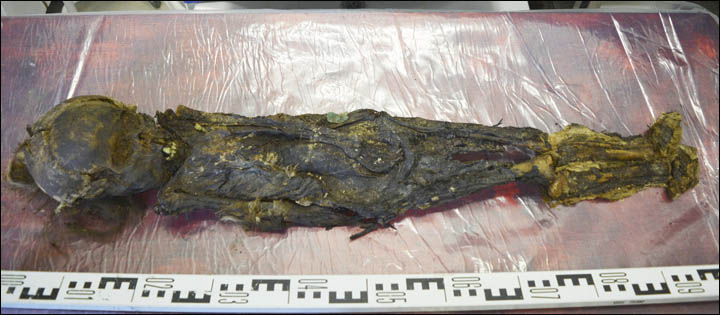
As he was a boy, the facial bones were not formed fully, so they were separated during the long period the remains were buried in the ground. ‘We are interested in the Khanty and Nenets populations, and also in an isolated group of Komi, who live near Lake Muzhi.’
Scientists are confident of obtaining sufficient DNA quality from the mummy, despite difficulties. ‘We are working now on extracting the good samples of DNA from the probes we have taken,’ he said.
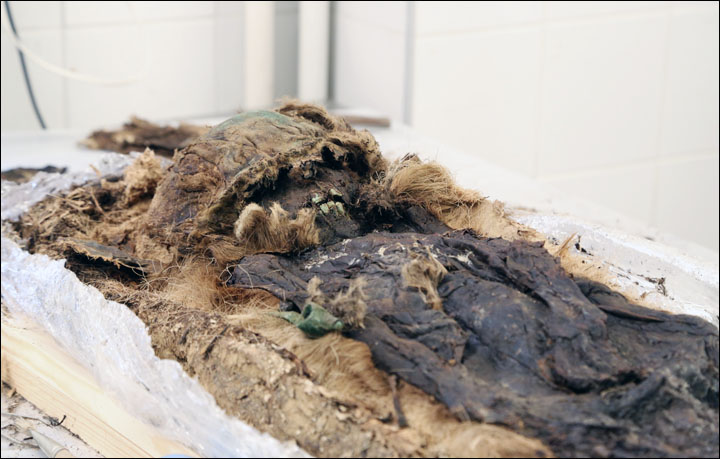
‘It is quite complicated, because the body was wrapped in birch bark and the birch resin made a powerful blow to the tissues. Besides the body unfroze and refroze again for several times. The DNA we get is not very clean, and there is not very much of it. But at the moment we are working to clear the DNA and get more samples and as soon as we succeed we will start the analysis.
‘First we will sequence the mitochondrial DNA to say to which ethnical group it related on the maternal line. The next step will be to analyse the nuclear DNA to find out his roots from paternal side.’
When they take modern-day samples with which to compare the ancient boy, they will seek locals who are known to be ‘ethnically clean back to their great grandparents’. Luckily it is easier to find such people among indigenous people, than among, say, Russians, so I believe that we will gather enough samples for our research,’ he said.
‘The main thing for us is to provide the clean probes. Actually we are the last generation who can gather such material, because after this cross-breeding will increase significantly.’
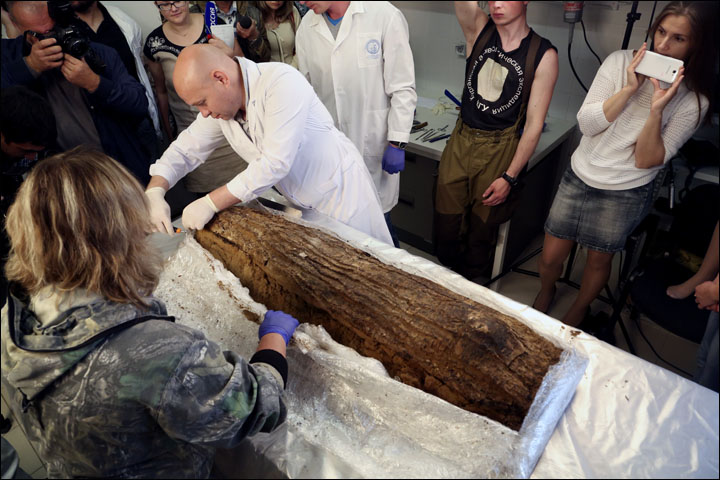
Sergey Slepchenko, a fellow researcher of the Institute of the Problems of Northern Development, Tyumen, said: ‘There is an agreement with Seoul University, and they plan to take probes and sequence DNA, check on stable isotopes, and then search for ectoparasites in the skins of animals found in the grave.
‘Yet the big and long project is our attempt to restore the face of the boy. It will be quite long, because first we need to restore the skull. As he was a boy, the facial bones were not formed fully, so they were separated during the long period the remains were buried in the ground.
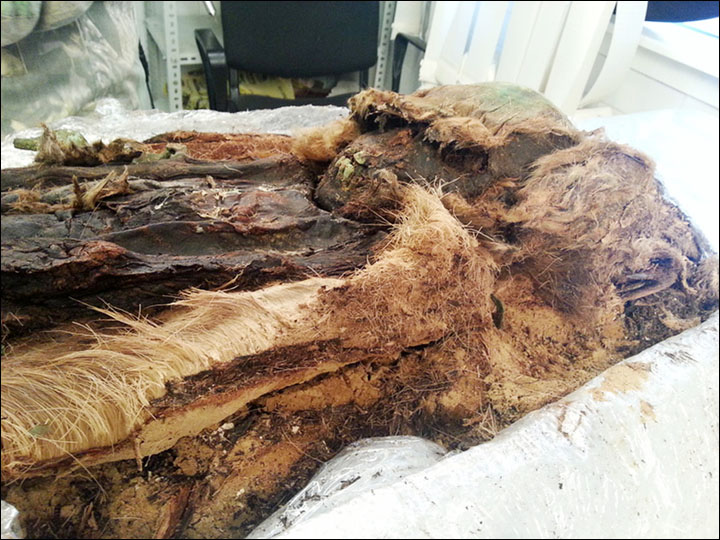
‘The skin on the face is almost intact, but the bones are separated. That means that we need to go a more complicated way – using computer tomography we will put together the facial bones, and bones of the skull, and then reconstruct the face. This quite a long process and the most part it will be undertaken by Koreans.’
Intriguing results have been obtained already on analysis of the contents of the boy’s intestines. ‘We have made a small cut and took a probe of contents – totally about one gram. The first interesting result was that there was no pollen here, that means that the boy probably died in late autumn or in winter.
‘He was buried at a cold time of the year and this may help the natural preservation of his body, along with the copper plates and cold climate. The other interesting thing is that we have found opisthorchis.’ In other words, he had worms.
‘That means that the boy at the age of 6 or 7 ate raw fish or half cooked fish. This tell us about the way of life of these people.’
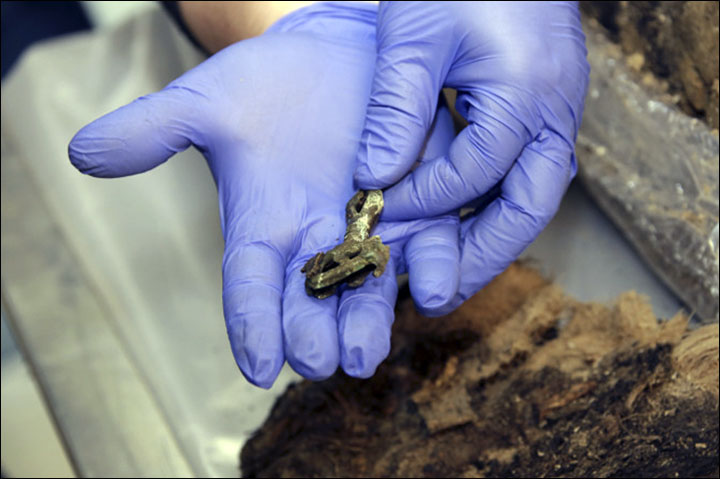
Previously from the same graveyard, evidence has been found of the parasitic disease opisthorchiasis among younger children. ‘We studied samples taken from the burial of an infant, unearthed in 2014 at the same Zeleny Yar site. The age was from six months to one year, but even such a little baby had opisthorchiasis.
‘The children here were fed with raw fish from the very early age. The infant could be given a piece of a raw fish to suck or fish was provided as a paste or gruel. We plan to conduct the paleo-parasitology research further to obtain a more detailed picture of the eating habits of these people.’
He said it was too early to tell that the people were malnourished.
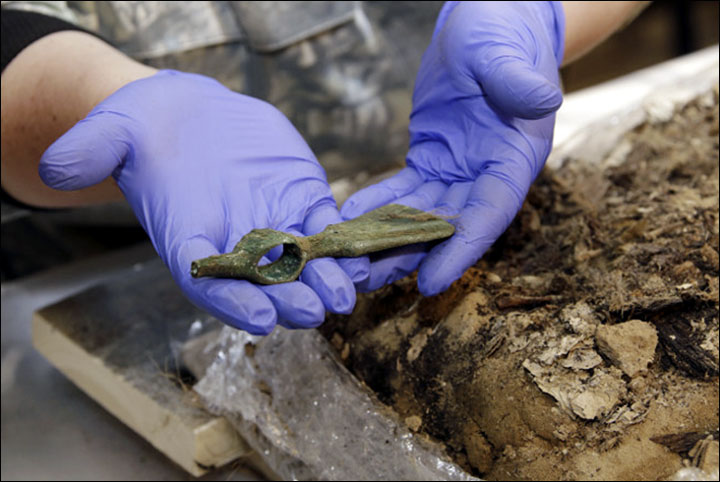
Archaeologist Alexander Gusev, research fellow at the Centre for the Study of the Arctic, Salekhard, said: ‘We have made a new base for the mummy and now keep it in special freezer. We are not going to preserve it with chemicals until scientists have taken all the probes they need.’
Following the mummy’s discovery, scientists announced last July that the remains date from the 12th or 13th centuries AD. Mr Gusev said at the time that the birch bark and copper coffin was 1.30 metres in length and 30 centimetres at its widest.
At the time, they believed it was the remains of ‘a child, maybe a teenager’. ‘The mummification was natural,’ said Mr Gusev. ‘It was combination of factors: the bodies were overlain with copper sheets, parts of copper kettles and together with the permafrost, this it gave the preserving effect.’
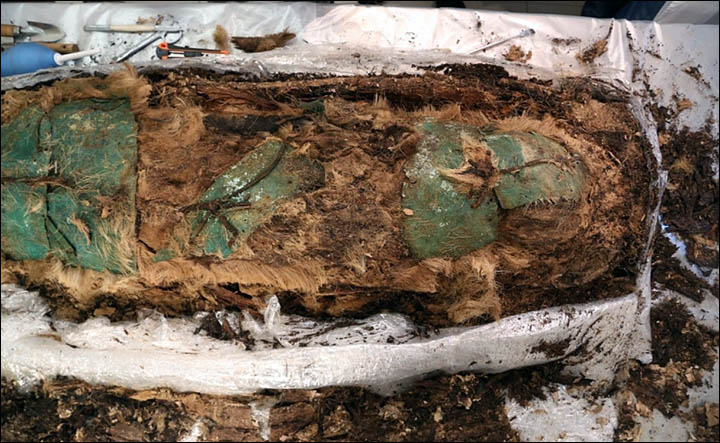
Previously, archeologists found 34 shallow graves at the medieval site, including 11 bodies with shattered or missing skulls, and smashed skeletons. Five mummies were found to be shrouded in copper, while also elaborately covered in reindeer, beaver, wolverine or bear fur.
Among the graves found so far is just one female, a child, her face masked by copper plates. Intriguingly, there are no adult women. Nearby were found three copper masked infant mummies – all males. They were bound in four or five copper hoops, several centimetres wide.
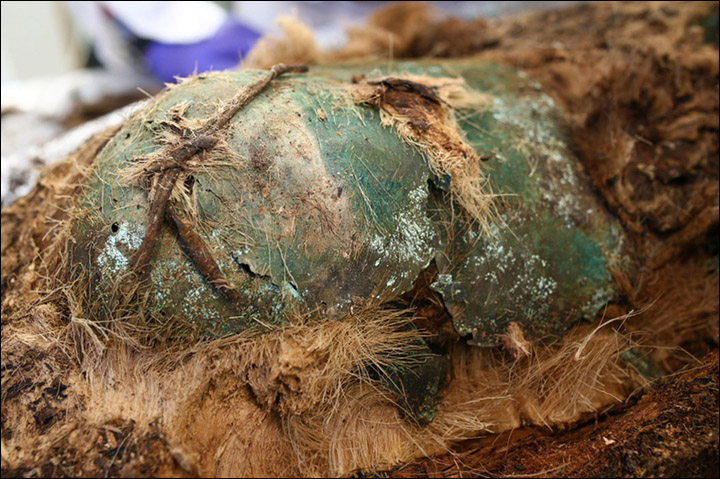
Similarly, a red-haired man was found, protected from chest to foot by copper plating. In his resting place, was an iron hatchet, furs, and a head buckle made of bronze depicting a bear. The feet of the deceased are all pointing towards the Gorny Poluy River, a fact which is seen as having religious significance. The burial rituals are unknown to experts.
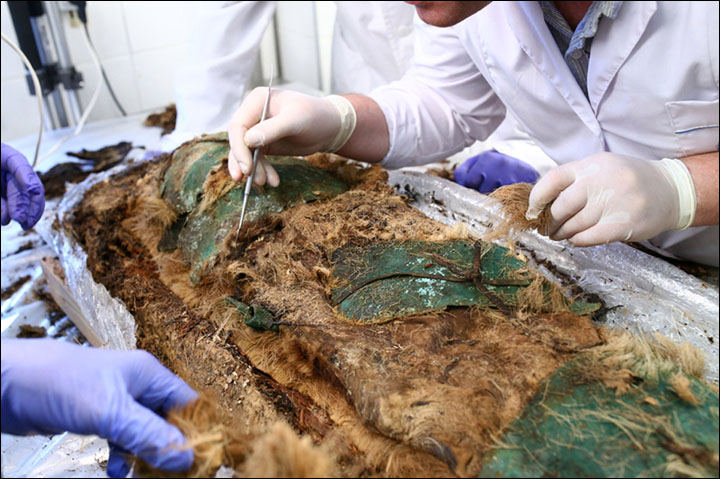
Artifacts included bronze bowls originating in Persia, some 3,700 miles to the south-west, dating from the tenth or eleventh centuries. One of the burials dates to 1282, according to a study of tree rings, while others are believed to be older.
The researchers found by one of the adult mummies an iron combat knife, silver medallion and a bronze bird figurine. These are understood to date from the seventh to the ninth centuries.
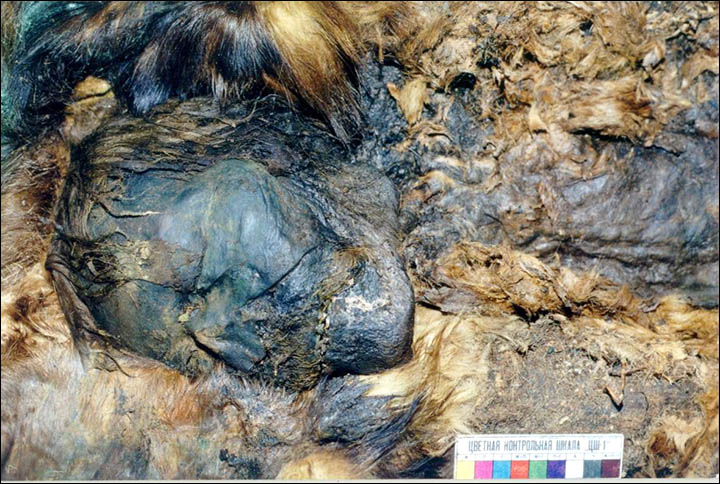
Five mummies were found to be shrouded in copper, while also elaborately covered in reindeer, beaver, wolverine or bear fur. Pictures: The SIberian Times, Natalya Fyodorova
Unlike other burial sites in Siberia, for example in the permafrost of the Altai Mountains, or those of the Egyptian pharaohs, the purpose did not seem to be to mummify the remains, hence the claim that their preservation until modern times was an accident.

The soil in this spot is sandy and not permanently frozen. A combination of the use of copper, which prevented oxidation, and a sinking of the temperature in the 14th century, is behind the good condition of the remains today.
Natalia Fyodorova, of the Ural branch of the Russian Academy of Sciences, said previously: ‘Nowhere in the world are there so many mummified remains found outside the permafrost or the marshes.
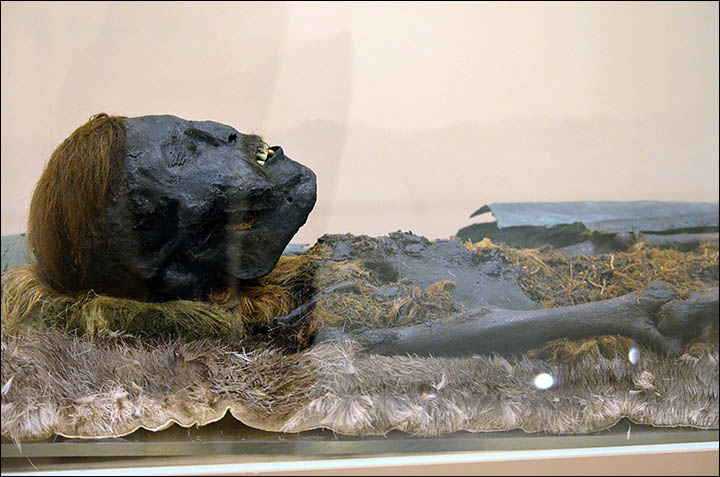
‘It is a unique archaeological site. We are pioneers in everything from taking away the object of sandy soil (which has not been done previously) and ending with the possibility of further research.’
In 2002, archeologists were forced to halt work at the site due to objections by locals on the Yamal peninsula, a land of reindeer and energy riches known to locals as ‘the end of the earth’.
The Institute of Molecular Genetics is part of the Russian Academy of Sciences. The Institute of the Problems of Northern Development is part of the Siberian Branch of the Russian Academy of Sciences.





